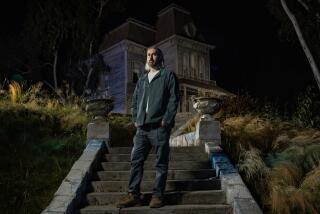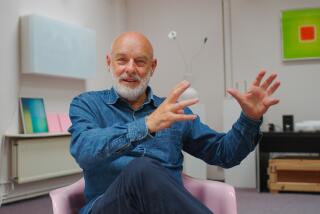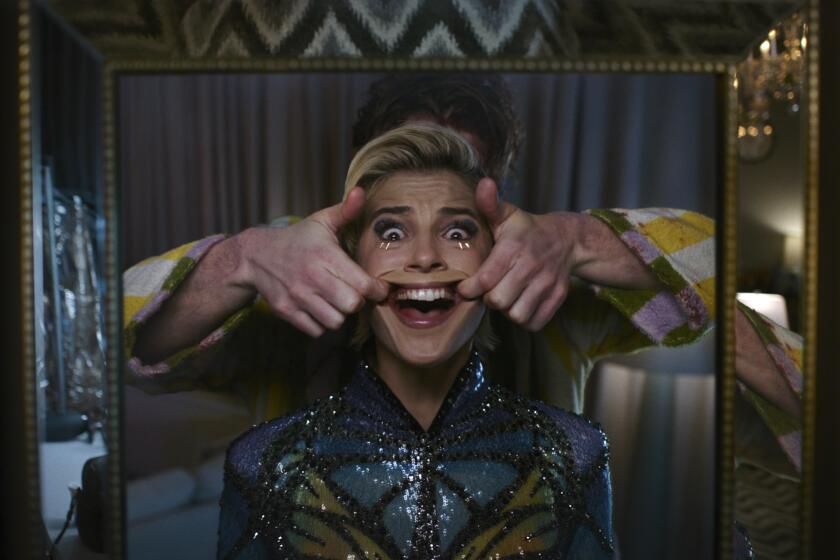Itâs Been His Look, No Matter Whoâs Directing
In an industry in which people routinely scramble for work, movie production designer Henry Bumstead has never had to worry about his next paycheck. In fact, during his 63-year career, Bumstead has never been laid off. âI have never been fired,â he says matter-of-factly. âI attribute it all to the fact that I have worked with good scripts and good directors and good actors and actresses. I have been lucky.â
âBummy,â as he is known in Hollywood, is still going strong at 87, thanks in no small part to his ongoing relationship with actor-director-producer Clint Eastwood. Bumstead first met Eastwood on the 1972 western âJoe Kidd,â directed by John Sturges. It was the beginning of a beautiful friendship and prolific working relationship.
They have collaborated on âHigh Plains Drifterâ (1972); âUnforgivenâ (1992), for which he received an Oscar nomination; âA Perfect Worldâ (1993); âThe Stars Fell on Henriettaâ (1995), which Eastwood produced but didnât direct; âAbsolute Powerâ (1997); âMidnight in the Garden of Good and Evilâ (1997); âTrue Crimeâ (1999); âSpace Cowboysâ (2000); and Eastwoodâs latest film, âBlood Work,â which opens today.
Eastwood says there was a near 20-year span between âHigh Plains Drifterâ and âUnforgivenâ because Bumstead was tied up working with directors Alfred Hitchcock and George Roy Hill on various projects. âFinally, when those guys all retired, I got him back,â Eastwood says. âI love to see a guy his age having so much fun working.â
Bumstead returns the compliment--in his own no-frills way.
âI have worked with Hitchcock, George Roy Hill, [Martin] Scorsese and Billy Wilder, but Clint has taken the bull out of making films,â says Bumstead, relaxing recently in the living room of his comfortable home in San Marino. âHe could keep doing Dirty Harry and westerns and just go right along, but he tries everything.â
âI tell him how I kind of see things,â Eastwood explains. âBut I tell him go ahead and he will show me things along the way. In fact, heâll want to show me more things than I want to see. But when you have good people like that, you can trust them to deliver. âUnforgivenâ was fun because he got to build a town from scratch. We scouted it together from a helicopter and found a place in Alberta [Canada] that we liked and he just built it.â
Considering his stature in the business, Bumstead is remarkably down-to-earth and unpretentious. A tall bear of a man, he has been slowed down a bit by having both knees replaced with metal implants, but he doesnât call attention to it. According to Eastwood, he is easily embarrassed when any fuss is made about him on the set. âWhen I say things like, âBumstead, will you just tell me where you want the camera and Iâll just go ahead and do it?â Heâll go, âAw, all right.â He gets all bashful and red.â
Bumstead has a cameo of sorts in âBlood Workâ that will no doubt make him cringe. Itâs in the form of a painting of Bumstead that adorns the wall of a police station. âThat wasnât his idea,â Eastwood says. âThe art department did it as a joke but I went ahead and used it.â
*
Pleased With Ship Set
In âBlood Work,â based on the thriller by former Los Angeles Times reporter Michael Connelly, Eastwood plays an FBI agent forced into retirement after suffering a heart attack while pursuing a serial killer. Two months after he gets a heart transplant, though, heâs back on the trail.
âBlood Workâ was shot in and around Los Angeles and Long Beach. Bumstead is especially proud of the elaborate interior he built for an old ship at Long Beach Harbor that is the setting for the movieâs action-packed finale.
âWe built this fantastic interior set of the boat with the engine room flooded with water,â he says enthusiastically. âThat was a big set and I got to do some wonderful aging. I love aging. I am a stickler for aging--the rust and the dirt. It was just a beautiful set.â
Bumsteadâs work isnât flashy and never intrudes on a story. But his designs are such an integral part of a film, they become characters in and of themselves. For example, would âUnforgivenâ have been as effective without Bumsteadâs spare but evocative designs of Eastwoodâs desolate, claustrophobic house or the rough-and-tumble frontier town?
Nominated for four Academy Awards, Bumstead has won Oscars for his haunting depiction of 1930s rural Alabama in âTo Kill a Mockingbirdâ (1962) and for bringing to vibrant life the colorful underbelly of Depression-era Chicago in âThe Stingâ (1973).
Jack De Govia, president of the Art Directors Guild--the terms art director and production designer are essentially interchangeable and often the two will work together on a project--praises the âmarvelous easeâ of Bumsteadâs designs.
âI canât tell you how splendid and how simple âUnforgivenâ was. It was not flashy. It was very strong and very real. There wasnât a thing there that didnât serve the story. Even in richer films like âThe Sting,â there was something that was soaked in about it. It has real depth. He doesnât put the curlicues on it. He doesnât need to make a display. He does what is needful, but he does it completely. There is a wonderful solidity to his images.â
In a youth-obsessed industry, De Govia praises Eastwood for using Bumstead in his films. âCongratulations to Eastwood for seeing what we know--there is absolutely no reason why a talent as broad and capable as his should be wasted at his age.â
âHe has a quick mind,â Eastwood says. âWhen youâve got someone who is classic like that, why let them go to waste?â
*
âBest Decision of My Lifeâ
Born in Ontario, Bumstead was a high school football player and valedictorian who had a choice of a number of colleges. âI made the best decision of my life. I chose USC because they had an architecture and fine arts course there, and that is what I really wanted to do--draw.â
He began interning at the RKO art department during the summer between his sophomore and junior year. He also landed summer work at Universal with an interior decorator who worked with the studios. The decorator introduced him to art director Hans Dreier (âSunset Boulevardâ), who was one of the top designers at Paramount.
âHe was absolutely fantastic,â Bumstead says of Dreier. âHe hired me and, boy, I learned so much from him. And then his assistant, Roland Anderson, was Cecil B. DeMilleâs art director, and he took me under his wing and I worked for him seven years before I became an art director. Nowadays, people start out as an art director after two or three months, but the thing is, after seven years, I knew my job very well. My first picture was âSaigonâ [1948] with Alan Ladd. He was a big star, and from there I was off.â
At Paramount, Bumstead worked almost exclusively for producer Hal Wallis, designing the Jerry Lewis-Dean Martin comedies âMy Friend Irmaâ (1949), âSailor Bewareâ (1952) and âJumping Jacksâ (1953) as well as such acclaimed dramas as âCome Back Little Shebaâ (1952), âThe Bridges at Toko-Riâ (1954) and âRun for Coverâ (1955), directed by Nicholas Ray.
Bumstead got his next big break while working on the forgettable 1956 costume drama âThe Vagabond King,â directed by Michael Curtiz.
âThe cameraman on the picture was Bob Burks, who was Hitchâs cameraman,â he says. âHitch said to Bob Burks, âDo you know any young art directors?â â And it just so happened he did. âI went up to see Hitch and he hired me for âThe Man Who Knew Too Much.â â
Bumstead worked with Hitchcock on three more films: âVertigoâ (1958), for which he received an Oscar nomination; âTopazâ (1969); and the directorâs last movie, âFamily Plotâ (1976).
âI had a great relationship with Hitch,â says Bumstead. âHitch liked the comfort of the stages and that is why he liked the rear-projection process. I think a young art director today who looked at âVertigoâ would ask me what did I do. Because nowadays they would shoot all of those actual locations. But everything was a set.â
Bumstead recalls picking an actual location off the Universal lot for âFamily Plot.â
The script called for a night scene at a house that had an attached garage. âI looked for two days for that location,â he says. âThe set was all lit and there were 120 people standing around. It was a cool night and Hitchcockâs car pulled up--he always rode in the front seat--and the window went down just so far and he said, âWhat are we doing here? How do you expect me to get a performance out of my actors on a cold night like this?â
â âI think we should do it back in the studio.â And the limo pulled off.â
*
Too Late for Computers
Bumstead isnât thrilled with the extensive use of computers to create designs and special effects. âI donât have a computer,â he says. âI donât have e-mail. It is too late for me. The first time I was really involved in that was on âSpace Cowboys.â I worked with ILM [Industrial Light & Magic] on that, so I was able to get through that. I did the designing and then they did all the special effects. Digitally, the things they can do now are unbelievable, but as far as to my liking, they have gone overboard--but thatâs just an old manâs opinion.â
Bumstead, whoâs married and the father of four grown children, is in pre-production on Eastwoodâs next picture, âMystic River,â a mystery set in Boston. Filming is set to start at the end of September. And Eastwood is planning on keeping Bumstead gainfully employed as long as he wants to work. âI may retire before he does,â 72-year-old Eastwood says with a hearty laugh.
More to Read
Only good movies
Get the Indie Focus newsletter, Mark Olsen's weekly guide to the world of cinema.
You may occasionally receive promotional content from the Los Angeles Times.











